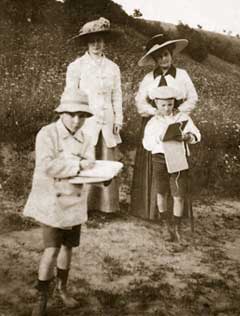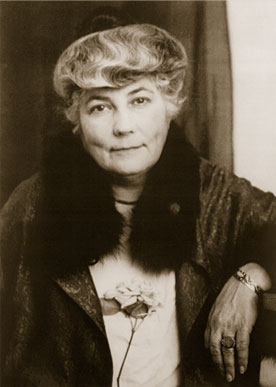 |
| printer friendly | |||
|
|||
Helena Ivanovna Roerich (1879 – 1955)
The truly great is always seen from a distance. As regards the Russian philosopher and writer Helena Roerich’s creative heritage, this was exactly the case. Much of what was created by this outstanding woman in the first half of the XX century entered the cultural and spiritual life of Russia comparatively recently, and aroused deep and sincere interest from many of our compatriots, who were trying to find answers to urgent questions concerning existence.
Helena Roerich was born on the 12th of February 1879 in Saint Petersburg, in the family of the architect-academician Ivan Shaposhnikov and his wife Ekatherina Vasilevna, whose maiden name had been Golenischeva-Kutuzova and who was the grand-niece of the great Field-Marshall Kutuzov. Through her maternal line, Helena was a distant relative of the outstanding Russian composer M. Mussorgsky.
From a very early age, the girl displayed outstanding abilities and, by the age of seven, she could read and write in three languages. Still very young, Helena took serious interest in literature and philosophy. After graduating from the Mariinsky Gymnasium and receiving a musical education, a brilliant pianist career awaited her, but life decided differently.
In 1899, at her aunt’s, Princess Y. Putyatina, estate, Helena Shaposhnikova first met the young painter N. Roerich, who not only became her husband, but also her associate, with whom she shared the same ideas. Unity of views, spiritual proximity and deep reciprocal feelings made this union extraordinarily strong. Already in the later days of his life Nicholas Roerich wrote about his marriage: “Together we were overcoming all kinds of encumbrances. And obstacles were turning into capacities. I dedicated my books to Helena, my wife, friendess, companion, inspirer"[1, p.460]. “Friendess” – “druginya” – is an ancient Russian word that very precisely corresponded to Helena Roerich’s spirit and character. Many of N. Roerich’s paintings were the result of their common creative work, it was, as matter of fact, a “co-creativity”, in which Helena Roerich was the inspiring source. As Nicholas Roerich wrote: “We were creating together, and not in vain it was said that the created pieces should bear two names – a woman’s and a man’s”[2, p.460].
 | |
| Helena Roerich (on the right), George and Svetoslav
Roerichs. Bologoye, 1913 |
In August of 1902, their son Yuri was born: a future world-renowned scientist and orientalist. In October 1904, Svetoslav was born: a future artist, thinker and public figure.
H. Roerich was the heart, preceptress and the most important pillar of the Roerich family. Nicholas Roerich, Yuri Roerich and Svetoslav Roerich highly appreciated the role of Helena Roerich as the bright genius of the family. In his memories, S. Roerich noted: “For us and all who came into close contact with her, this spiritual communication was kind of a live assertion of the highest verities of the ever-lasting truth. Her life was shining like a live luminaire, establishing with its example the existence of a beautiful world, comprehension of which will lead the humanity to new achievements, new discoveries”[3].
N. Roerich called Helena Roerich “She Who Leads” in his creations. At the same time, she was a person of amazing modesty. Having entered the life of a famous artist, she always kept in the shadow. Most of her works were published under pseudonyms. “<…> let me get down from the pedestal erected by your beautiful, loving heart <…> I like simplicity in everything, and any pomposity and solemnity are organically intolerable for me. I don’t like to teach, but just to pass knowledge”[4, p.246], she wrote in one of the letters to her friend.
Having found themselves cut off from their Motherland by the revolutionary events of 1917, the Roerichs left for England. There in London, in 1920, H. Roerich started writing down the first lines of the Living Ethics – a new philosophic system representing a modern integral concept of real Cosmos. The Living Ethics books were being created by H. Roerich in close collaboration with a group of anonymous philosophers who are usually called Mahatmas (Great Souls) or Rishis (Teachers) in the spiritual tradition of India.
In the autumn of 1920, together with her husband and children, H. Roerich left for New York, where Nicholas Roerich had planned a series of exhibitions in several USA cities.
In America, under N. Roerich’s leadership and with H. Roerich’s direct participation, a small group of their associates launched large-scale cultural and educational activities. The results of their activities were striking: the creation of the “Roerich Museum”, of the “Master Institute of United Arts” and of the international artistic center “Corona Mundi”. These institutions, organized by Nicholas and Helena Roerich, turned into major cultural centers, the influence of which spread far beyond the country’s borders and becoming international. Numerous societies, creative clubs and educational institutions, offering their services all over the world under the aegis of these organizations, united under the common dome of Culture, not only creative people, but also all those who strove for the implementation of humanistic ideals and improvement of life conditions. “It fills you with joy,” Helena Roerich wrote, “to see how, in the days of destruction, luminous souls come together in the name of Culture, trying to preserve the fire and give the happiness of creativity and expansion of consciousness to those who are seeking for a way out of the formed intellectual deadlock, which is also entailing material disaster”[5, p.386].
|
|
||
|
||
